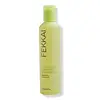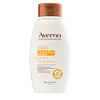What's inside
What's inside
 Key Ingredients
Key Ingredients

No key ingredients
 Benefits
Benefits

 Concerns
Concerns

 Ingredients Side-by-side
Ingredients Side-by-side

Water
Skin ConditioningSodium Cocoyl Isethionate
CleansingSodium Lauroyl Methyl Isethionate
CleansingLauryl Glucoside
CleansingHeptyl Glucoside
Disteareth-75 Ipdi
Coconut Acid
CleansingPunica Granatum Seed Oil Stearyl Esters
EmollientGlyceryl Oleate
EmollientPyrus Malus Fruit Extract
Skin ConditioningVinegar
Sorbitan Oleate
EmulsifyingSodium Isethionate
CleansingGlycerin
HumectantHydroxypropyl Guar Hydroxypropyltrimonium Chloride
Zingiber Officinale Root Extract
MaskingCaprylyl/Capryl Glucoside
CleansingMagnolia Officinalis Bark Extract
AntimicrobialPanthenol
Skin ConditioningXylitol
HumectantEpilobium Angustifolium Flower/Leaf/Stem Extract
Skin ConditioningPhaeodactylum Tricornutum Extract
HumectantPiper Nigrum Seed Extract
RefreshingLeptospermum Scoparium Branch/Leaf Oil
TonicSalvia Hispanica Seed Extract
EmollientCaesalpinia Spinosa Fruit Extract
Skin ProtectingLavandula Angustifolia Flower Extract
CleansingPelvetia Canaliculata Extract
Skin ProtectingLeontopodium Alpinum Extract
Skin ConditioningHydrolyzed Vegetable Protein
Skin ConditioningOryza Sativa Seed Protein
AntioxidantOryza Sativa Bran Extract
Skin ConditioningOryza Sativa Extract
AbsorbentHelianthus Annuus Sprout Extract
Skin ConditioningHelianthus Annuus Extract
EmollientRosmarinus Officinalis Leaf Extract
AntimicrobialSalicylic Acid
MaskingGalactaric Acid
Trehalose
HumectantArginine PCA
HumectantMaltodextrin
AbsorbentHydroxypropyl Methylcellulose Stearoxy Ether
Ethyl Oleate
EmollientPolyquaternium-37
Tocopherol
AntioxidantEthyl Linoleate
EmollientGluconolactone
Skin ConditioningCalcium Gluconate
HumectantOctyldodecanol
EmollientSodium Phosphate
BufferingEthylhexylglycerin
Skin ConditioningPotassium Sorbate
PreservativeSodium Benzoate
MaskingChlorphenesin
AntimicrobialBenzyl Alcohol
PerfumingAlcohol
AntimicrobialPhenoxyethanol
PreservativeCaprylyl Glycol
EmollientCaprylic Acid
CleansingParfum
MaskingPhytic Acid
Sodium Phytate
Trisodium Ethylenediamine Disuccinate
Sodium Metabisulfite
AntioxidantPentaerythrityl Tetra-Di-T-Butyl Hydroxyhydrocinnamate
AntioxidantTbhq
AntioxidantLimonene
PerfumingGeraniol
PerfumingLinalool
PerfumingCitronellol
PerfumingCitral
PerfumingEugenol
PerfumingHexyl Cinnamal
PerfumingAmyl Cinnamal
PerfumingCitric Acid
BufferingPotassium Hydroxide
BufferingWater, Sodium Cocoyl Isethionate, Sodium Lauroyl Methyl Isethionate, Lauryl Glucoside, Heptyl Glucoside, Disteareth-75 Ipdi, Coconut Acid, Punica Granatum Seed Oil Stearyl Esters, Glyceryl Oleate, Pyrus Malus Fruit Extract, Vinegar, Sorbitan Oleate, Sodium Isethionate, Glycerin, Hydroxypropyl Guar Hydroxypropyltrimonium Chloride, Zingiber Officinale Root Extract, Caprylyl/Capryl Glucoside, Magnolia Officinalis Bark Extract, Panthenol, Xylitol, Epilobium Angustifolium Flower/Leaf/Stem Extract, Phaeodactylum Tricornutum Extract, Piper Nigrum Seed Extract, Leptospermum Scoparium Branch/Leaf Oil, Salvia Hispanica Seed Extract, Caesalpinia Spinosa Fruit Extract, Lavandula Angustifolia Flower Extract, Pelvetia Canaliculata Extract, Leontopodium Alpinum Extract, Hydrolyzed Vegetable Protein, Oryza Sativa Seed Protein, Oryza Sativa Bran Extract, Oryza Sativa Extract, Helianthus Annuus Sprout Extract, Helianthus Annuus Extract, Rosmarinus Officinalis Leaf Extract, Salicylic Acid, Galactaric Acid, Trehalose, Arginine PCA, Maltodextrin, Hydroxypropyl Methylcellulose Stearoxy Ether, Ethyl Oleate, Polyquaternium-37, Tocopherol, Ethyl Linoleate, Gluconolactone, Calcium Gluconate, Octyldodecanol, Sodium Phosphate, Ethylhexylglycerin, Potassium Sorbate, Sodium Benzoate, Chlorphenesin, Benzyl Alcohol, Alcohol, Phenoxyethanol, Caprylyl Glycol, Caprylic Acid, Parfum, Phytic Acid, Sodium Phytate, Trisodium Ethylenediamine Disuccinate, Sodium Metabisulfite, Pentaerythrityl Tetra-Di-T-Butyl Hydroxyhydrocinnamate, Tbhq, Limonene, Geraniol, Linalool, Citronellol, Citral, Eugenol, Hexyl Cinnamal, Amyl Cinnamal, Citric Acid, Potassium Hydroxide
Colloidal Oatmeal Extract
HumectantWater
Skin ConditioningSodium C14-16 Olefin Sulfonate
CleansingCocamidopropyl Betaine
CleansingVinegar
Polyquaternium-22
PEG-7 Amodimethicone
HumectantLinoleamidopropyl Pg-Dimonium Chloride Phosphate
Polyquaternium-39
Sodium Hydrolyzed Potato Starch Dodecenylsuccinate
PEG-150 Pentaerythrityl Tetrastearate
EmulsifyingPPG-2 Hydroxyethyl Cocamide
EmulsifyingPropylene Glycol
HumectantHexylene Glycol
EmulsifyingSodium Citrate
BufferingCitric Acid
BufferingSodium Hydroxide
BufferingSodium Benzoate
MaskingParfum
MaskingColloidal Oatmeal Extract, Water, Sodium C14-16 Olefin Sulfonate, Cocamidopropyl Betaine, Vinegar, Polyquaternium-22, PEG-7 Amodimethicone, Linoleamidopropyl Pg-Dimonium Chloride Phosphate, Polyquaternium-39, Sodium Hydrolyzed Potato Starch Dodecenylsuccinate, PEG-150 Pentaerythrityl Tetrastearate, PPG-2 Hydroxyethyl Cocamide, Propylene Glycol, Hexylene Glycol, Sodium Citrate, Citric Acid, Sodium Hydroxide, Sodium Benzoate, Parfum
 Reviews
Reviews

Ingredients Explained
These ingredients are found in both products.
Ingredients higher up in an ingredient list are typically present in a larger amount.
Citric Acid is an alpha hydroxy acid (AHA) naturally found in citrus fruits like oranges, lemons, and limes.
Like other AHAs, citric acid can exfoliate skin by breaking down the bonds that hold dead skin cells together. This helps reveal smoother and brighter skin underneath.
However, this exfoliating effect only happens at high concentrations (20%) which can be hard to find in cosmetic products.
Due to this, citric acid is usually included in small amounts as a pH adjuster. This helps keep products slightly more acidic and compatible with skin's natural pH.
In skincare formulas, citric acid can:
While it can provide some skin benefits, research shows lactic acid and glycolic acid are generally more effective and less irritating exfoliants.
Most citric acid used in skincare today is made by fermenting sugars (usually from molasses). This synthetic version is identical to the natural citrus form but easier to stabilize and use in formulations.
Read more about some other popular AHA's here:
Learn more about Citric AcidParfum is a catch-all term for an ingredient or more that is used to give a scent to products.
Also called "fragrance", this ingredient can be a blend of hundreds of chemicals or plant oils. This means every product with "fragrance" or "parfum" in the ingredients list is a different mixture.
For instance, Habanolide is a proprietary trade name for a specific aroma chemical. When used as a fragrance ingredient in cosmetics, most aroma chemicals fall under the broad labeling category of “FRAGRANCE” or “PARFUM” according to EU and US regulations.
The term 'parfum' or 'fragrance' is not regulated in many countries. In many cases, it is up to the brand to define this term.
For instance, many brands choose to label themselves as "fragrance-free" because they are not using synthetic fragrances. However, their products may still contain ingredients such as essential oils that are considered a fragrance by INCI standards.
One example is Calendula flower extract. Calendula is an essential oil that still imparts a scent or 'fragrance'.
Depending on the blend, the ingredients in the mixture can cause allergies and sensitivities on the skin. Some ingredients that are known EU allergens include linalool and citronellol.
Parfum can also be used to mask or cover an unpleasant scent.
The bottom line is: not all fragrances/parfum/ingredients are created equally. If you are worried about fragrances, we recommend taking a closer look at an ingredient. And of course, we always recommend speaking with a professional.
Learn more about ParfumSodium Benzoate is a preservative. It's used in both cosmetic and food products to inhibit the growth of mold and bacteria. It is typically produced synthetically.
Both the US FDA and EU Health Committee have approved the use of sodium benzoate. In the US, levels of 0.1% (of the total product) are allowed.
Sodium benzoate works as a preservative by inhibiting the growth of bacteria inside of cells. It prevents the cell from fermenting a type of sugar using an enzyme called phosphofructokinase.
It is the salt of benzoic acid. Foods containing sodium benzoate include soda, salad dressings, condiments, fruit juices, wines, and snack foods.
Studies for using ascorbic acid and sodium benzoate in cosmetics are lacking, especially in skincare routines with multiple steps.
We always recommend speaking with a professional, such as a dermatologist, if you have any concerns.
Learn more about Sodium BenzoateIn cosmetics, vinegar is often used to help adjust the pH of a product. It is also a light exfoliant. The pH of your skin is important to maintain a healthy skin barrier.
Vinegar is created by the process of double-fermentation. It is an aqueous solution consisting mostly of water and acetic acid. Typically, vinegar contains anywhere from 5-8% acetic acid.
Other components include small amounts of contains small amounts of tartaric acid and citric acid. Depending on what is used to ferment the vinegar, it can have traces of flavoring as well.
Learn more about VinegarWater. It's the most common cosmetic ingredient of all. You'll usually see it at the top of ingredient lists, meaning that it makes up the largest part of the product.
So why is it so popular? Water most often acts as a solvent - this means that it helps dissolve other ingredients into the formulation.
You'll also recognize water as that liquid we all need to stay alive. If you see this, drink a glass of water. Stay hydrated!
Learn more about Water